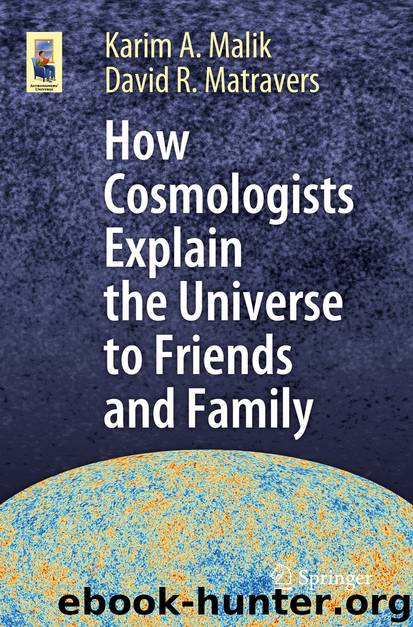How Cosmologists Explain the Universe to Friends and Family by Karim A. Malik & David R. Matravers

Author:Karim A. Malik & David R. Matravers
Language: eng
Format: epub
ISBN: 9783030327347
Publisher: Springer International Publishing
6.4.2.3 Gravitational Waves
Another surprising consequence of Einstein’s theory of general relativity are gravitational waves. It took astronomers roughly hundred years until gravitational waves were directly observed for the first time on 14 September 2015 by the LIGO gravitational wave observatory. We discussed LIGO already in Sect. 3.3.4.2, but let us now discuss what gravitational waves are.
Gravitational waves are ripples in spacetime, as introduced in Sect. 3.2.2.2 when we discussed non-standard messengers in astronomy. We can get an idea of what this means if we replace the rubber-sheet in our lower dimensional analogy introduced above by the smooth surface of a pond. If we throw a small pebble into the pond, waves on the surface of the water will travel outwards from the point of impact. Similarly, gravitational waves are distortions of spacetime that travel outwards from their source with the speed of light, stretching and compressing spacetime periodically as they pass. As explained in Sects. 3.2.2.2 and 3.3.4.2, these periodic deformations of spacetime can be measured, or observed, using gravitational wave observatories. We can use a mirror as a “test-mass” by carefully suspending it in such a way that can it can respond to the periodic ripples of spacetime, like a cork bobbing up and down on the surface of a pond if a small ripple or wave passes it. As discussed in Sect. 3.3.4.2, we can then use interferometry to make the extremely tiny movements of the mirror visible.
However, this is just an analogy, gravitational waves are not surface waves, they are ripples of spacetime itself, periodic changes in the curvature of spacetime. If we think of spacetime as an elastic entity, like a jelly, gravitational waves are oscillations travelling through the jelly. Like water waves on the surface of a pond or electro-magnetic waves, gravitational waves oscillate perpendicular to their direction of motion, this is also referred to as being “transverse”. This is by no means obvious, as for example sound waves are pressure oscillations in a medium, and the medium gets compressed along the direction of travel. Gravitational waves travel at the speed of light, that is 300, 000 km/s. Again, this is not obvious but follows from the theoretical framework and the equations of general relativity. Gravitational waves do not require a medium and can travel through empty space, like electromagnetic radiation. They also carry energy, like electro-magnetic and surface waves. A source emitting gravitational waves therefore looses energy.
Gravitational waves are generated when accelerating masses warp spacetime, leading to a sudden or a periodic change in the curvature of spacetime. The bigger the masses involved and the larger the acceleration, the stronger the gravitational waves emitted by the object or system. By stronger we mean here that the gravitational waves have larger amplitude, distorting spacetime more strongly, and carry away more energy.
If we accelerate a large mass suddenly we get a sudden change in the curvature of spacetime. A large mass corresponds to a strong curvature of spacetime, and if we somehow could accelerate this mass
Download
This site does not store any files on its server. We only index and link to content provided by other sites. Please contact the content providers to delete copyright contents if any and email us, we'll remove relevant links or contents immediately.
| Aeronautics & Astronautics | Astronomy |
| Astrophysics & Space Science | Comets, Meteors & Asteroids |
| Cosmology | Mars |
| Solar System | Star-Gazing |
| Telescopes | UFOs |
Tools of Titans by Timothy Ferriss(8215)
Turbulence by E. J. Noyes(7935)
Secrets of Antigravity Propulsion: Tesla, UFOs, and Classified Aerospace Technology by Ph.D. Paul A. Laviolette(5309)
Astrophysics for People in a Hurry by Neil DeGrasse Tyson(5130)
Room 212 by Kate Stewart(5035)
Design of Trajectory Optimization Approach for Space Maneuver Vehicle Skip Entry Problems by Runqi Chai & Al Savvaris & Antonios Tsourdos & Senchun Chai(5011)
Pale Blue Dot by Carl Sagan(4907)
The David Icke Guide to the Global Conspiracy (and how to end it) by David Icke(4624)
A Journey Through Divination and Astronomy by Publishing Pottermore(4341)
Goodbye Paradise(3724)
Apollo 8 by Jeffrey Kluger(3635)
COSMOS by Carl Sagan(3553)
Losing the Nobel Prize by Brian Keating(3498)
The Five People You Meet in Heaven by Mitch Albom(3474)
How to Read Water: Clues and Patterns from Puddles to the Sea (Natural Navigation) by Tristan Gooley(3406)
Brief Answers to the Big Questions by Stephen Hawking(3369)
How to Read Nature by Tristan Gooley(3249)
The Order of Time by Carlo Rovelli(3144)
A Brief History of Time by Stephen Hawking(2959)
